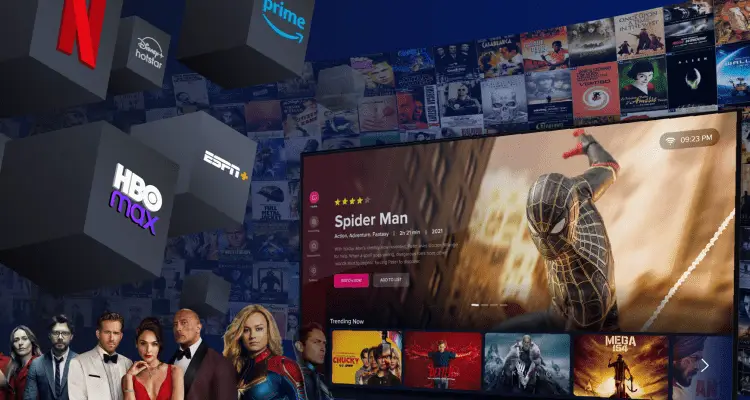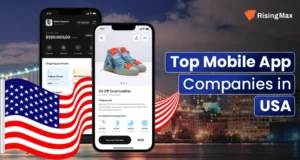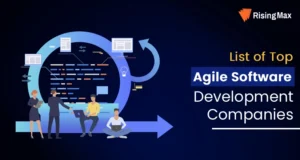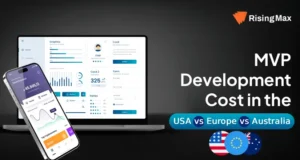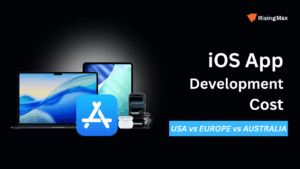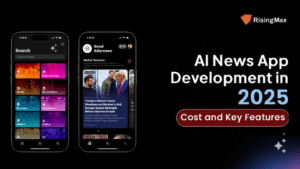OTT platforms have revolutionized how consumers access a wide range of audio and video content. OTT platforms have a substantial involvement in both viewership and market share.
According to Research and Markets, the over-the-top (OTT) market is projected to reach USD 194.20 billion by 2025. Various factors, including the increasing adoption of smartphones, widespread access to broadband, and affordable data plans, fuel significant investments in OTT platforms.

Streaming services have become popular for major media brands, sports leagues/federations, and businesses of all sizes to boost their brand recognition and engage with their audience.
However, the question still remains: How do OTT platforms make money? This article explores the various methods by which OTT platforms generate revenue.
OTT platforms have successfully implemented a range of revenue streams, including subscription-based models, advertising strategies, and partnerships. These strategies enable them to generate income while ensuring their audiences consistently engage with captivating content. Gaining a deep understanding of how these platforms generate revenue offers valuable insights into their business strategies and the ever-changing world of digital entertainment.
What Makes OTT Apps More Popular Than Traditional Platforms?
A large number of individuals have a preference for OTT applications over traditional television due to many reasons:
Cost: OTT apps are often more budget-friendly than their traditional counterparts. Customers can save money by opting out of equipment rentals and enjoy the benefits of reduced subscription prices.
Convenience: Having the flexibility to access content from any location and on any device is a significant advantage of OTT apps.
Content Selection: Regarding content selection, OTT apps may have some limitations. While they may not offer live channels, they usually make up for it by providing a wide range of movies and TV shows you can watch on-demand.
User experience: OTT apps provide a customized streaming experience with personalized recommendations, user profiles, and content filtering features.
Flexibility: Users can pause their subscriptions when they are not using them.
Device Choice: OTT apps can be used on various devices, including smartphones and smart TVs, providing users with more options to enjoy their preferred shows and movies.
No Equipment Needed: Unlike traditional television, OTT apps don’t require a set-top box, cable, or satellite dish.
Easy & Cost-Effective Platform Development: Creating or developing OTT apps is cost-effective. Depending on platform types and features, OTT app development costs between $20,000 to $65,000.
How Do OTT Platforms Acquire Content?
There are two different approaches that OTT platforms can take to acquire content:
Self-Production: OTT platforms bring together talented crews and provide funding to bring their creative ideas to life, producing a wide range of original movies and web series for streaming on their applications.
Purchasing Broadcasting Rights: When an OTT service wishes to showcase a movie or TV show on its platform, it can acquire the streaming rights from the producers. Our primary objective is to increase the number of subscribers by broadening the range of content offerings.
Build An Application Like Netflix Or Amazon Prime With Us!
How Does OTT Platform Make Money?
OTT platforms have numerous opportunities to monetize their content. Here is a list of the following:
1. Direct Advertising
Direct advertising provides greater control over your monetization strategy, enabling you to select the ads to display and determine their frequency. It also offers the opportunity to generate extra revenue by selling ad space or placements. While it can improve the user experience for your audience, it also has the potential to foster collaborations with advertisers and expand your reach.
Advertisers usually pay a fee to showcase their ads on the OTT platform. These ads can come in different forms, like pre-roll ads that appear before a video, mid-roll ads that play during a video, or banner ads that appear on the platform’s website or app.
Advertising on OTT platforms offers a great opportunity for precise targeting based on various factors such as demographics, geography, and viewing habits. Marketers can easily track the effectiveness of their advertisements and make necessary adjustments using the data collected from the OTT platform.
2. Video Ad Networks
Integrating a video advertising network (VAN) into your OTT service can be a lucrative opportunity to generate revenue swiftly. VANs connect you with advertisers looking for space to showcase their advertisements.
One major drawback of VANs is the lack of control over the advertisements displayed on your platform. If something offensive is played, your audience might hold you responsible.
Although VANs can alleviate the burden of searching for advertisers, it is still important to thoroughly research and carefully review the terms and conditions before committing to any VAN.
3. Catchup TV
With the Catchup TV business model, users can enjoy complete flexibility by downloading their favorite shows. For a limited time and at a special price, this eliminates any concerns your viewers may have about missing out on the most captivating shows.
4. Freemium
In this business model, some content sections can be accessed for free, while others are only available through a subscription or a one-time payment as a premium.
5. Best Sponsorship Deals
Advertisers can sponsor specific content through OTT sponsorship deals, similar to traditional television advertising.
There are various methods to deliver your sponsored messaging, including integrating it into content, showcasing it as banner ads, or featuring it on launch screens. Sponsorship deals can help simplify your ad rotation by decreasing the number of sponsoring brands you must manage.
6. Various Monetization Models
The OTT platform offers various monetization models for content marketers and video publishers in various industries.
6.1. AVOD
In exchange for strategically placed ads, consumers can enjoy video content available free for users through this model. Ad revenue covers the costs of production and distribution.
The AVOD model offers two options to consider:
- Signing up for video ad networks
- Direct advertising
Benefits of AVOD
User Acquisition: With video content being free, AVOD models have a higher probability of attracting substantial viewership. If you desire access to plenty of free content, dedicating a few moments to advertisements is a minor sacrifice.
Easy Revenue Distribution: For AVOD enthusiasts, there is a wide range of OTT video monetization platform options to choose from. Pre-roll ads are shown before the chosen video content is played, while midroll ads are strategically placed to pause the video and show ads. During the video, in-video ads appear on the screen and can be easily closed by the viewer.
6.2 Subscription Video on Demand (SVOD)
A subscription video-on-demand (SVOD) service provides users convenient access to a vast library of videos at their fingertips, all for a fixed monthly fee. Depending on the company’s pricing model, the fee can be billed daily, weekly, monthly, or annually. Once users have paid for the service, they can enjoy unlimited video content based on their chosen subscription. Companies such as Disney+, Amazon Prime, HBO, and Netflix utilize this business model. If you’re a creator or business with unique and specialized content, SVOD could be the ideal way to monetize your content, provided that consumers are willing to pay for it.
Benefits Of SVOD
Exceptionally high customer retention rate: The OTT platform offers round-the-clock access to exclusive content for a monthly subscription, incentivizing users to engage with services regularly.
Recurring Charging Models: The SVOD model eliminates the need for users to repeatedly insert their card details and saves businesses from the hassle of follow-ups.
6.3 TVOD/PPV
The pay-per-view model, also known as Transactional Video on Demand, enables users to buy and watch a single video. In the subscription model, users can enjoy unlimited videos, whereas in the transactional model, users are charged for each video they choose to watch. Viewers have the option to either purchase or rent a video.
Transactional-based platforms are highly regarded for their ability to offer convenient access to the latest releases and sporting events, making them a valuable and lucrative option.
Platforms that don’t have a vast collection of videos or content libraries can greatly benefit from a transactional-based model. Nevertheless, this platform type faces challenges building enduring relationships with its users. Continuously guiding customers through the payment process can hinder their willingness to engage with additional content.
Benefits of TVOD
Generates Increased Revenue: Customers are charged for each video they choose rather than purchasing an entire collection or series. This ensures a steady income stream, regardless of the length of the videos.
Creates a Niche Range of Videos: TVOD models enable content providers to establish direct connections with their audience and offer them engaging video content. This leads to a highly focused demographic and a particular group of videos.
6.4 Hybrid Model
Some OTT services choose to integrate multiple models. As an illustration, viewers can purchase a subscription to access a vast library of videos. In addition, customers must pay an additional fee to access the latest movie releases. At times, the service categorizes videos into two groups: those accessible with a subscription and those that come with an additional fee. The service utilizes both subscription-based and transactional-based models.
Certain OTT services employ a blend of advertising and subscription models. Users can choose between watching videos for free with ads or paying for an ad-free experience.
6.5 Multi-Screen Model
In this OTT business model, customers can watch movies on the go with a single subscription that works seamlessly across all their devices, such as iPads, tablets, smartphones, and more.
Which Model Is the Best Way to Make Money In OTT?
The revenue models we explained above have different ways of managing the economic aspects of OTT platforms. Before diving into any revenue model, consider the factors determining your business needs. Some of the factors that need to be considered are the type of content you offer to the users, your target audience, and the business strategy you need to use.
Choosing a suitable revenue model is confusing and requires a lot of research. In this case, contact the best OTT app development company, like RisingMax, that can help you choose the best revenue model for your platform and provide quality services and solutions to your users.
Global OTT Platform And Their Revenue Model
Over 300 OTT services in the United States provide content and promote various goods and services. Let us have a look at them:
1. Youtube
YouTube is a platform that allows people worldwide to access its content without any limitations based on location. It is easily accessible to anyone with an internet connection. Statistics reveal that an astounding amount of content, exceeding 400 hours, is uploaded to YouTube every minute. Additionally, the platform witnesses a staggering consumption of over 1 billion hours of video content annually.
The revenue generated from advertising on YouTube in the third quarter of 2023 amounted to $7.95 billion.
2. Amazon Prime
Amazon Prime offers customers the benefit of unlimited streaming video and music, along with the convenience of free two-day shipping. People are highly impressed by its multifunctionality beyond video streaming. An increasing number of individuals opt for video streaming applications due to their numerous advantages, including special discounts and complimentary shipping.
By the end of 2025, it is projected that Amazon Prime Video will have a staggering 168 million subscribers, as reported.
3. Netflix
Netflix is an online platform that offers a diverse range of movies, web series, and original content for users to enjoy. According to reports from 2023, Netflix generated a revenue of 854.17 Cr in September.
Netflix generates revenue solely from its subscribers. Netflix adopted the Subscription Video on Demand (SVOD) revenue model. Subscribers can access Netflix’s diverse content range by paying a subscription fee. After purchasing a Netflix subscription, the app becomes completely free of advertisements, ensuring it remains operational and profitable without relying on ads.
Want to Develop An OTT App?
As a leading OTT app development company in the USA, we have a seasoned team of experts who develop fresh, creative ideas daily.
Why Should You Invest in OTT App Development?
The OTT industry will probably experience a significant surge in the upcoming years. Given these circumstances, opting for NFT-based OTT app development can prove to be a wise decision as it offers numerous benefits:
A large number of subscribers: As the cord-cutting trend continues to gain momentum, the streaming market is experiencing significant growth. This is great news for the potential users of your app.
High demand: There is a strong demand for innovative applications that can address gaps in the market, as consumers are increasingly seeking a broader range of OTT content options.
New sources of income: Developing a popular OTT app can result in higher subscription fees, increased ad revenue, and boosted online sales.
Lower costs: OTT apps offer more cost-effective content and infrastructure expenses than traditional media platforms.
Connect with a leading mobile app development company today & get a consultation on how to get started.

